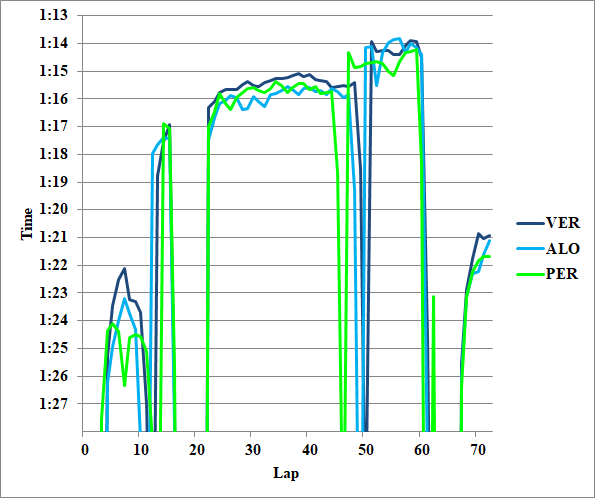
The four-week summer break is over, and the 2023 F1 season is finally entering the second half. The stage for the Dutch GP was the challenging and undulating circuit of Zandvoort.
The GP weekend was affected by severe weather changes throughout qualifying and the race, resulting in a dramatic and unpredictable event. In this article, we will look back at the performance of each team and driver, using data to support our analysis.
1. Verstappen Was Perfect in Any Condition
The race was a very challenging one, with rain falling right after the start, forcing most drivers to switch to intermediate tyres, then to dry tyres, and then a red flag in the final stages due to heavy rain, followed by a restart with six laps remaining. It was as if all the difficult elements of a race were packed into one.
Among them, Verstappen delivered a flawless race, achieving his ninth consecutive win, which ties the F1 record.
Verstappen perfectly controlled the race from pole position, but it was not a completely lonely drive.
In terms of the early rain, it was the best decision to change to intermediate tyres on lap one, and Verstappen was one lap late, so when he returned to the track, Perez was in a runaway situation, and he also lost out to Zhou and Gasly, effectively dropping to fourth place.
However, he passed Gasly on lap six and Zhou on lap seven, both in turn three. In wet conditions, DRS cannot be used, so drivers who can overtake at corners are very strong. Turn three has a large bank, and the outside is an absolutely advantageous racing line. However, Verstappen passed them from the inside, cleverly squeezing their line.
And from here, An incredible Verstappen’s strength in the rain was really shown. Figure 1 shows the race pace of Verstappen, Alonso and Perez.

In the early wet conditions, Verstappen’s pace was outstanding, more than a second faster than Perez. This high pace allowed him to close the gap to Perez to 2.7 seconds by lap 11, just before switching to dry tyres. And this led to an undercut.
His pace on dry tyres was also 0.3 seconds faster than Perez on average, which is also impressive.
And above all, he made no mistakes. Verstappen’s driving in recent races has been almost flawless, and this time too he was very stable throughout despite the changing conditions. With this performance, no one would doubt his achievement of tying Vettel’s record of nine consecutive wins.
2. Alonso Was Perfect in Any Condition
In such a difficult race, Alonso shone as brightly as Verstappen.
First of all, Alonso impressed with his start. He lined up on the outside of Albon at turn two and then took the inside at turn three, passing Russell as well. This line sacrifices exit speed, but he placed his car in front of Russell and blocked his way to complete the overtaking.
Then on lap two, under difficult conditions of driving on wet surfaces with dry tyres, he passed Norris at turn three again. He passed him from the inside this time too, but this was essentially different from his overtaking on lap one. On wet surfaces, you can find more grip if you avoid the racing line where rubber is laid. That’s why Alonso was able to accelerate more smoothly than Norris who ran on the normal dry line. In this corner, taking outside line has a high advantage due to the bank angle, so it is easy to understand Norris’ feeling of choosing the same line as in dry conditions, but here Alonso’s judgement was correct.
And Alonso also pitted on lap two like Verstappen. He lost positions but passed Leclerc on lap six at turn 10 from the inside and then lapped at a pace that was clearly faster than Perez although not as fast as Verstappen. Consequently, he caught up with Zhou and Gasly.
Then he changed to dry tyres at the same time as Zhou and passed him at turn three before Zhou’s medium tyres warmed up. Considering that the inside was wet at this time, this was a quite amazing move. He probably assessed Zhou’s tyre grip at the pit lane exit and turn two. And then he might have thought that if he dived in with that speed difference, he could brake on the wet inside at entry and then change his car direction neatly after going out to the outside (although he was already changing his car direction quite well at entry…). His versatility of overtaking skill is so impressive.
By the way, his pace on dry tyres was 0.5 seconds slower than Verstappen, 0.2 seconds slower than Perez, and 0.1 seconds faster than Gasly. Aston Martin, who had lost their momentum in the early races, seemed to have recovered quite well judging from this pace.
He also showed a flawless drive in the rain, while Perez went off the track, and took a splendid second place.
3. Summary and Outlook
Zandvoort is a difficult circuit in itself, with bumps, low, medium and high speed corners, combinations of corners, narrow width, grave, and so on… And in the midst of such conditions, the weather changed dramatically, making it the most challenging possible condition. In such a situation, the skills of two great champions shone.
These two drivers, as mentioned in the mid-season review (currently Japanese only), have a 0.4 second gap to their teammates in absolute pace. They are at a very high level in everything: speed, stability, battle skills, communication with the team, etc. The heated attack battle in Monaco GP qualifying is still fresh in our memory.
Reference: Mid-season review (1)
From now on, what will they show us in the highest level of motorsport F1? And what kind of battles will emerge with Hamilton, Leclerc, Norris and others? It’s a very exciting start to the nine races in three months.
Writer: Takumi